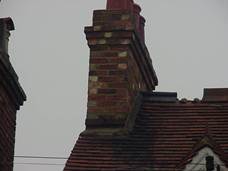Builders, Building Problems and Roofs
and how a Surveyor can help you
Building Problems
 We pride ourselves on our high standards of work on many different types of properties such as terraced houses, bungalows, and semi-detached houses. We also survey and write reports on commercial properties to. We can help you by preparing Building Surveys and Structural Surveys on new properties when you come to purchase them or when you come to want to carry out repair work or new extensions. We can relate this work and the problems to the value of the property and give true independent valuations.
We pride ourselves on our high standards of work on many different types of properties such as terraced houses, bungalows, and semi-detached houses. We also survey and write reports on commercial properties to. We can help you by preparing Building Surveys and Structural Surveys on new properties when you come to purchase them or when you come to want to carry out repair work or new extensions. We can relate this work and the problems to the value of the property and give true independent valuations.
Building and builder problems
Where you have a specific problem we carry out a Specific Defects Report. This could for example relate to a building problem of which we have a wealth of knowledge and experience on. Please do not hesitate to call us on our free phone number 0800 298 5424.
Always have an independent building survey?
We as independent Surveyors always having an independent building survey as this will highlight any property problems. Caveat emptor means buyer beware and is why you need to have a building survey to find out if there are any problems within the property; the estate agent certainly will not advise you of any.
Remember the independent building Surveyor that you employ will be the only person working for you with your interests at heart at all times.
Free phone 0800 298 5424
What does the circles and ovals system mean in our building surveys?
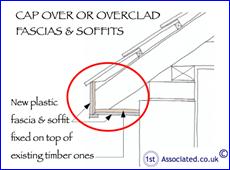
In our building surveys and structural surveys the circles and ovals are a system that we used to highlight property problem areas so that you are not left wondering what the property problem is.
In addition to this if the survey photographs do not we believe explain the property problem enough together with our survey report we also add in one of our own survey sketches.
The roof problem is clear for all to see but every builder has a different view
 We were called in by a client to look at a house that they had inherited. They had been told by various different builders it had many problems. Our client was concerned that the builders had all spotted different problems or told him different things and he was confused about what was really going wrong with the building if anything at all, or were the builders just looking for work/to make a quick buck. As the client didn't live at the property this also meant that he had limited time to show lots of builders around so he called on the services of us as Independent Building Surveyors to advise him what was really wrong with the property.
We were called in by a client to look at a house that they had inherited. They had been told by various different builders it had many problems. Our client was concerned that the builders had all spotted different problems or told him different things and he was confused about what was really going wrong with the building if anything at all, or were the builders just looking for work/to make a quick buck. As the client didn't live at the property this also meant that he had limited time to show lots of builders around so he called on the services of us as Independent Building Surveyors to advise him what was really wrong with the property.
Is the house falling down?
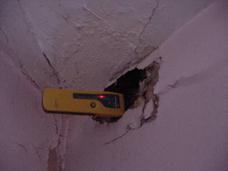
The clients biggest concern was that one of the builders had advised him he needed a new roof yet when you looked at the roof from the outside of the building it didn't look to sag or dip, although when you viewed the house from the inside it was a different matter as there was plaster coming off the wall and brick visible in some areas and dampness visible in many areas.
Sometimes building problems look worse than they are and sometimes building problems look better than they are
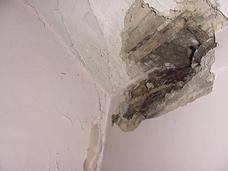
There is no rhyme or reason as to what it shows on the surface of the building. You need to remember that you are looking at the effect rather than the cause.
Establishing the facts of the roof and the building problem
As Building Surveyors we will always be looking to establish the facts. We are looking for the cause of the problem rather than the effect. Both the photos above show the effect of the property problem.
Considering specifically the roof problem (we did actually look at other building problems within the house as well) the fact of the matter was that we could see and also record with electronic resistance damp meters dampness getting into the structure to the front right hand side and to both of the front chimneys. This was visible in the form of plaster coming off of the wall and exposing the rafters and wall plate and fibreglass beneath it. There was also a very large damp patch visible to parts of the wall both at the front and the rear in the corner of the roof.
Cause and effect, who do you believe when talking about a building problem?
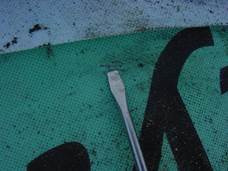
We have mentioned about cause and effect and that most surveyors will be looking for the cause whilst most builders are looking for the effect. We would even go as far as to say that many clients are more than happy for the builder to sort out the effect rather than the cause as they are unaware that in a year or two or maybe more the effect will come back. A good / bad builder so to speak may be able to make a repair look good for a few years but if they haven't resolved the cause the problem will always come back.
Easy building solutions first if they are appropriate
We always look to solve the things the easiest way first if that's the appropriate way to solve it. We always focus on solving the cause rather than the effect. The problem is best shown by a sketch of a wall plate to understand how this part of the building is detailed which will in turn show and explain to any builder that is trying to resolve this problem. The above building problem with regard to the roof that we have just discussed, the dampness coming into the front right hand side which in turn was taking the plaster off the wall and exposing the common rafters, the ones that form the pitch to the roof and the wall plate, the ones that give the bonding between the top of the wall and the roof, these are all problems and you need to establish the cause of the problem. There was also adjoining dampness visible in the chimney. Was this related or not? This is another question that we would ask.
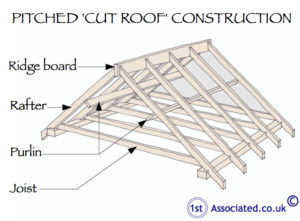
Common Rafters Defined
The rafters form the slope to which the battens are secured and in turn the roof covering is also secured too.
Builders normally deal with the effect rather than the cause of the building problem
Just to reiterate in our experience as independent Surveyors after many years we always find builders deal with the effect which in this case for the roof problem would be replacing the damp plaster and the rotting timbers with new timbers and modern plaster at best. At worst one builder/roofer said that the entire roof needed renewing. We would comment this really is making a mountain out of a molehill.
 Where builders do deal with the cause it's very rare they look at it in the long term
Where builders do deal with the cause it's very rare they look at it in the long term
Again in our experience as surveyors after many, many years dealing with builders even the better ones that try and deal with the actual cause of the problems normally find that it is in the nature of the builder/roofer to do it the easiest way possible for them (insurance companies are the same to!). They don't really think about the long term effects and they certainly don't think of the problems the clients may have in many years to come as quite often where a problem has been hidden for a few years and then reappears the client will think that the original builder did a good job and phone them to come and do some more work or put it right again.
Short term sticking plaster solutions
 It's interesting that Surveyors deal with the building industry that can make mistake after mistake over years and decades and even hundreds of years yet actually the builders get the benefit of these mistakes by then being called back to repair them.
It's interesting that Surveyors deal with the building industry that can make mistake after mistake over years and decades and even hundreds of years yet actually the builders get the benefit of these mistakes by then being called back to repair them.
Cement flashings to chimneys don't work in the long term
The home owner advised that he had, had the chimneys repaired when he first inherited the house as they were damp as dampness was visible coming into the property and yet the chimneys were still damp. We examined these; this was a clue to the quality of repair used elsewhere.
|
|
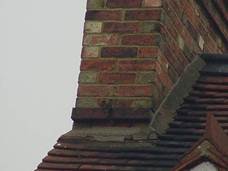 |
|
A far off picture |
A close up view |
What could the problem be with the roof?
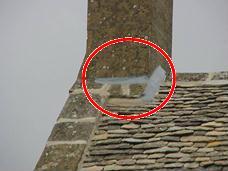
We could see that the chimneys had, had a new cement flashing added. Whether or not this was the original problem we didn't know but we know that the cement flashing had cracked over a relatively short time and allowed water in. Cement is one of the worst materials to repair a chimney flashing with or indeed any roof flashing as they do not have the flexibility. If you look at the photo you will see a different chimney in a different town, which has had a cement flashing repair. Then, in addition to this, the cement flashing has cracked and this in turn has had a rubberised paint put on it.
Interestingly if you go back some years ago and look at older properties you will see lead flashings that have lasted for many decades if not hundreds of years. Lead is a very flexible material which allows for movement between the chimney and the roof and keeps the joint watertight, which is after all what you are trying to do to avoid dampness getting in and causing the plaster to deteriorate.
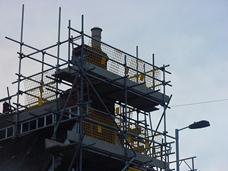 |
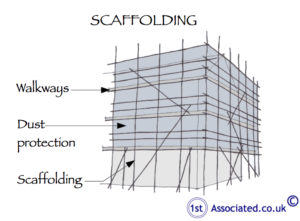 |
|
Repairs to chimneys can be expensive as you may need scaffolding access
|
Sketch of scaffolding over a house for high level work |
Some further thoughts for the more observant of you that have your own roof problems
Some older roofs do look like they have cement flashings however the cement that was used would in fact have had lime in it which makes the cement much more flexible than the modern Portland cement that was introduced after the war.
 |
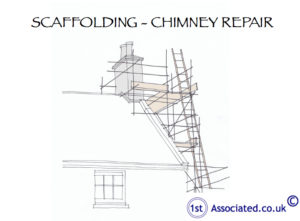 |
|
Repairs to chimneys can be expensive as you may need scaffolding access
|
Sketch of scaffolding over a house for high level work |
Does the property need a new roof? Ask an independent Surveyor.
 What was causing the client most concern and probably the main reason why they phoned us was that one of the builders has said that the property needed a new roof. He may have to lift off the entire roof to carry out a repair to the wall plate. The first problem the client had was he didn't really understand what a wall plate was. (See our definition and sketches above again for a better understanding). The main thought was obviously he was very concerned about being advised by the builder that he had to remove the entire roof. He was particularly concerned when this all seemed to relate to one relatively small patch of damp to the right hand side front wall of the property although he could see that where the builder had removed the plaster the damp timber underneath was clearly very rotten and almost sponge like in softness. We inspected the roof from the outside and it didn't look like there were any major problems with it. There would normally be dips or a lean within the roof. We inspected the roof from the inside and again it didn't look like there would be massive problems within the roof. We explained what a wall plate is. This is a timber plate that sits at the top of a wall that allows a joint between the timber roof.
What was causing the client most concern and probably the main reason why they phoned us was that one of the builders has said that the property needed a new roof. He may have to lift off the entire roof to carry out a repair to the wall plate. The first problem the client had was he didn't really understand what a wall plate was. (See our definition and sketches above again for a better understanding). The main thought was obviously he was very concerned about being advised by the builder that he had to remove the entire roof. He was particularly concerned when this all seemed to relate to one relatively small patch of damp to the right hand side front wall of the property although he could see that where the builder had removed the plaster the damp timber underneath was clearly very rotten and almost sponge like in softness. We inspected the roof from the outside and it didn't look like there were any major problems with it. There would normally be dips or a lean within the roof. We inspected the roof from the inside and again it didn't look like there would be massive problems within the roof. We explained what a wall plate is. This is a timber plate that sits at the top of a wall that allows a joint between the timber roof.
Caveats
We need to caveat this story by saying that the problems that we find are very specific to the building, the age, the type and style, the amount of maintenance that has been carried out, the area that they are in and the materials used. So if it sounds like you have a similar problem make sure you speak to someone who really knows what they are doing.
What can an independent Surveyor do for you?
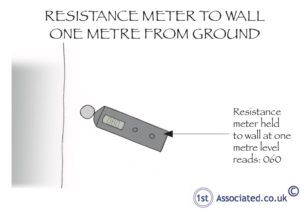 In this case we took damp meter readings using an electronic resistance damp meter along the front wall and found that the dampness was only approximately one metre or three foot whichever you are using, to the right hand side and the rest of the wall was dry.
In this case we took damp meter readings using an electronic resistance damp meter along the front wall and found that the dampness was only approximately one metre or three foot whichever you are using, to the right hand side and the rest of the wall was dry.
As the house was empty we asked the owner then if we could actually open up the area. Remember the owner was actually our client in this instance. It may not be possible where you are buying a house and you will have to rely on our experience from days like this when we do actually get to open up the property.
We then took a hammer and chisel to the wall and removed the plaster. We quickly saw to one side that it was dry as our electronic damp meter had said and to the other side interestingly a modern gypsum plaster had been used rather than the old alignment plaster that we could see. This meant that it absorbed water very much like blotting paper and amazingly behind this was cement that also absorbs the water like blotting paper. So it was clearly a repair that had been carried out in the past 30 or so years. Unfortunately this repair had caused the area to act very much like a large sponge and hold water. In turn this water then had rotted the wall plate; however we were still only looking at the effect. We needed to establish the cause.
To do this we opened up more of the structure until we had opened all the wet areas. This;
1/ Allows you to establish exactly where the problem is and the limits of it which then means if you get any quotes you will know that the whole roof doesn't need to be replaced as it is only a small section
2/ Allows air to get around the problem and start the drying out process
3/ Allows any builders to clearly see what the problem is and quote
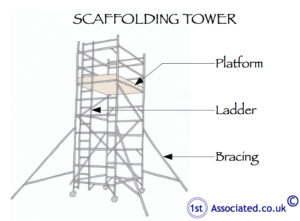 However as mentioned this damp area is the effect rather than the cause. You could see that concrete and the gypsum plaster had been holding the water in this area together with the embossed wallpaper. You could also see that the hog back tile that had been used between the roof of this property and next doors property had cement underneath it and we think that water was getting in underneath this area where the cement had cracked no doubt over time. Further investigation is needed by a long ladder but this is much more likely than needing to replacing the entire roof.
However as mentioned this damp area is the effect rather than the cause. You could see that concrete and the gypsum plaster had been holding the water in this area together with the embossed wallpaper. You could also see that the hog back tile that had been used between the roof of this property and next doors property had cement underneath it and we think that water was getting in underneath this area where the cement had cracked no doubt over time. Further investigation is needed by a long ladder but this is much more likely than needing to replacing the entire roof.
We also had the discussion that we could in theory just repair the damaged area and then accept that in thirty years the problem would reoccur. We could have long ladders/scaffold tower and have a thorough examination. So we have moved this problem from being a tens of thousands of pounds problem to one that will be a few thousand pounds at the most and we will actually be resolving the problem rather than the effect.
We would refer you to other interesting surveying articles on our website:
Accessing chimneys
Damp Meters
Damp Proof Courses in older properties
Dampness a different view
Independent Surveyors
If you truly do want an independent expert opinion from a surveyor with regard to valuations, mortgages, mortgage companies, surveys, building surveys, structural reports, engineers reports, specific defects report, structural surveys, home buyers reports or any other property matters please contact 0800 298 5424 for a friendly chat.
We highly recommend you always make sure when you have a survey your meet your Surveyor at the property.
We can email you examples of our structural surveys
We would be happy to email you some examples of our tailor made reports, Structural Surveys, Commercial Building Surveys, Schedules of Condition, Structural Surveys and Property Reports. We can send you examples of Structural Surveys on, we believe, every type of property and era. Property eras are most typically Tudor and Elizabethan, Georgian and Regency, Victorian and Edwardian, War Years, Post War Years, Modern and New.
We have example surveys of every type of commercial property including shops, offices, industrial buildings, leisure buildings such as pubs, sports centres, places of worship and institutional buildings.
Commercial Property
If you have a commercial property, whether it is freehold or leasehold then sooner or later you may get involved with dilapidation claims. You may wish to look at our Dilapidations Website at www.DilapsHelp.com and for Disputes go to our Disputes Help site www.DisputesHelp.com .
Articles written by independent Surveyors
We hope you found the article of use and if you have any experiences that you feel should be added to this article that would benefit others, or you feel that some of the information that we have put is wrong then please do not hesitate to contact us (we are only human).
The contents of the website are for general information only and are not intended to be relied upon for specific or general decisions. Appropriate independent professional advice should be paid for before making such a decision.
All rights are reserved the contents of the website are not to be reproduced or transmitted in any form in whole or part without the express written permission of www.1stAssociated.co.uk .

